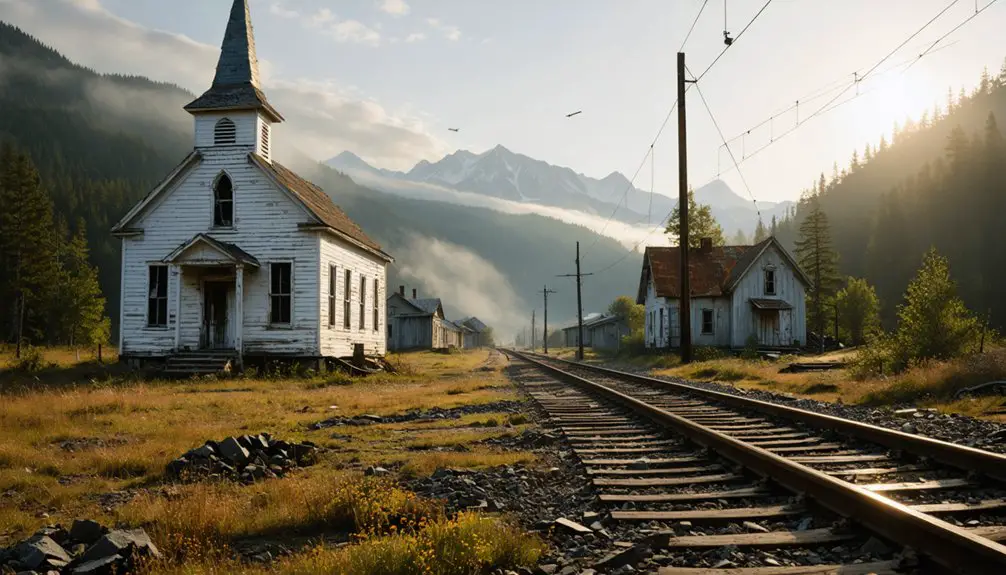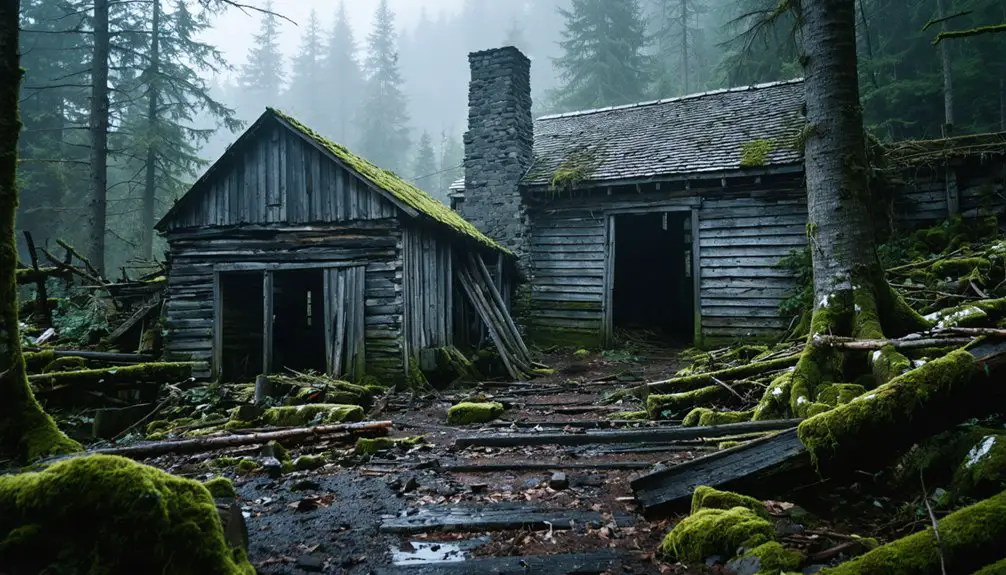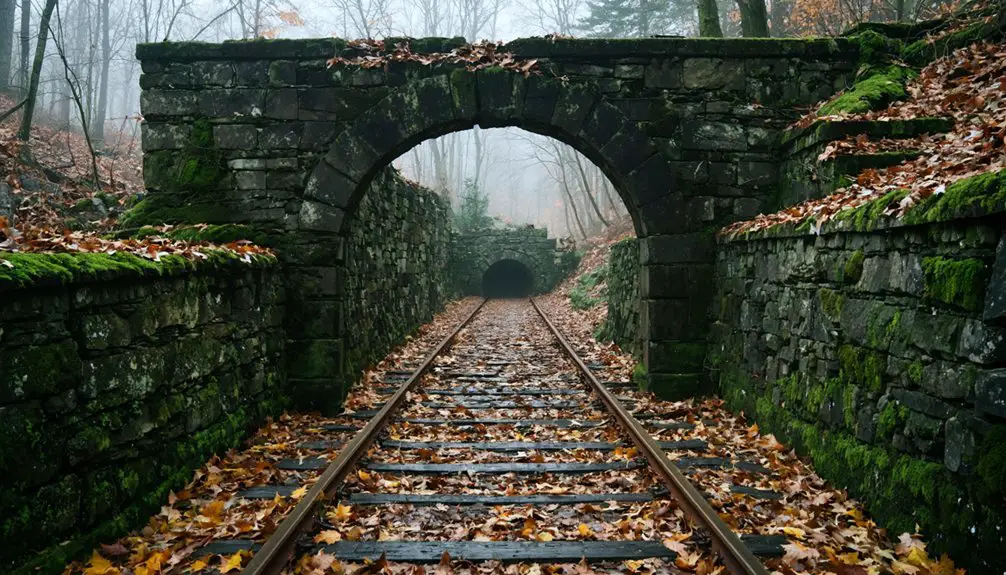You’ll find Barclay nestled high in Pennsylvania’s mountains, where coal’s accidental discovery in 1812 transformed a remote settlement into a thriving community of 3,000 residents. By 1856, the innovative Barclay Railroad connected miners to broader markets, with production reaching 200,000 tons annually by 1869. After the coal seams depleted and a devastating 1900 flood struck, the town slowly emptied. Today, only the weathered marble headstones of Barclay Cemetery tell the mountain’s forgotten stories.
Key Takeaways
- Barclay was a thriving coal mining town that reached 3,000 residents before becoming abandoned in the early 20th century.
- The town’s decline began with depleted coal seams and the closure of the Barclay Railroad in 1899.
- A destructive flood in 1900 damaged crucial infrastructure, accelerating the town’s abandonment.
- Only the Barclay Cemetery and crumbling church foundations remain as visible remnants of the once-prosperous mining community.
- The ghost town’s location is 3-5 miles up Barclay Mountain off Route 514 in Pennsylvania.
The Rise of a Coal Mining Settlement
While the Barclay area was initially purchased in 1794 by London merchant Robert Barclay, significant development wouldn’t begin until coal’s accidental discovery in 1812 by hunter Absalom Carr on Barclay Mountain.
Early Barclay history shows resourceful miners using simple techniques, sledding coal down the mountain to supply local blacksmiths. The high-quality semi-bituminous coal became highly sought after for steam engines and household use.
You’ll find the real transformation came in 1856 when the Barclay Railroad connected this remote settlement to broader markets, spurring rapid growth and community resilience.
The economic impact was tremendous – by 1875, you’d see a thriving town of 2,000 residents with stores, churches, and schools carved into the mountainside.
The Erie Railroad’s mining operations reached an impressive 200,000 tons annually by 1869, cementing Barclay’s position as an essential coal producer.
Life on Barclay Mountain
In your daily routine as a Barclay Mountain coal miner, you’d start work before sunrise, spending long hours underground in hazardous conditions for $1.50 to $1.75 per day.
When Saturday’s shift ended, you’d join other mining families at the town center near the creek, where children played while adults shared stories of the week’s events. The town’s name sometimes caused confusion since there were several other place name disambiguations related to Barclay.
Despite the harsh climate and demanding work schedule, you’d find moments of respite during these weekend gatherings, though they remained simple affairs given the physical toll of mining life. Coal from the mines was transported down the mountain using the incline planerail system that served as the town’s lifeline.
Daily Coal Mining Routines
Life for coal miners on Barclay Mountain revolved around grueling daily routines at nearly 2,000 feet elevation. You’d start your shift by making the tough climb up the mountain, where mining safety was a constant concern in the rugged terrain.
The Erie Company pushed hard to meet demanding quotas, reaching 200,000 tons annually by 1869. Your workday meant intense physical labor, extracting coal manually while battling harsh conditions and labor struggles. During peak operations, miners earned up to $200 monthly.
The Barclay Coal Company transported equipment and miners up the mountain to keep operations running continuously after 1856. At day’s end, you’d watch loaded coal cars descend the incline plane while empty ones returned uphill via cable system.
Mining crews also maintained essential infrastructure like brake houses and rail lines to keep the coal flowing to Towanda.
Community Gatherings and Recreation
Beyond the demanding coal mining routines, Barclay Mountain residents found joy through vibrant community gatherings and recreation. You’d find families gathering at popular spots like “Granny” Hunter’s and “Granny” McNally’s shops, where children enthusiastically bought candy and gum.
The town reached its peak when the population hit 3,000, creating a bustling social atmosphere throughout the community. Local picnics brought everyone together on the mountain, while horse-drawn hack rides offered thrilling adventures along snowy roads. The tight-knit community demonstrated their care by organizing benefit dances to support neighbors facing hardships.
The tradition of community storytelling lives on through “Old Home Day” reunions, where former residents share cherished memories of their mountain life. These social traditions continue at the old picnic grounds each summer, as descendants connect with their roots.
Even today, informal rides to historic town routes and cemetery visits keep the spirit of Barclay alive, preserving the rich tapestry of mountain community life.
The Engineering Marvel of the Gravity Railroad
At the heart of Barclay’s coal operations, you’ll find an ingenious gravity railroad system that used loaded coal cars’ weight to pull empty cars uphill, creating a perpetual transport cycle across the mountain.
The system’s inclined planes, powered by 90-horsepower steam engines, could lift four-ton coal cars at speeds of 370 feet per minute, while carefully graded descents allowed cars to coast downhill naturally.
The railroad’s innovative “barney car” design and hemp rope system, which required weekly maintenance due to the owners’ Quaker practices, transformed coal transport across Pennsylvania’s challenging terrain. A pioneer of gravity-based transport, Josiah White first envisioned this revolutionary system with his iron-clad wooden rails in 1818. The railroad’s efficiency increased dramatically when engineers implemented a separate light track for returning empty cars in 1844.
Mechanics Behind Coal Transport
The innovative gravity railroad system in Barclay revolutionized coal transport through its remarkably simple yet effective design. You’d find loaded coal cars descending the scientifically engineered track at a uniform grade of 75 to 100 feet per mile, completing their journey in just 30 minutes using nothing but gravity mechanics.
The coal logistics were brilliantly straightforward: loaded cars rolled downhill on iron-strapped wooden rails, while mules transported empty cars back uphill on specially designed cars with feed troughs. This system cut transport costs by a third compared to traditional methods. The first US railroad began operating in 1827, setting the standard for future coal transport systems.
Multiple daily round trips were possible, despite the two-and-a-half-hour uphill return. The gravity railroad’s integration with the Delaware and Hudson Canal created an efficient network that powered the northeastern United States’ industrial growth throughout the 19th century.
Legacy of Mountain Innovation
While Barclay’s transport system proved efficient, an even more groundbreaking gravity railroad emerged in 1827 at Summit Hill, Pennsylvania. This marvel of mountain engineering transformed coal transport through rugged terrain, combining gravity-powered descents with stationary steam engines on steep inclines.
The industrial innovation showcased at Summit Hill included:
- Iron-strapped wooden rails covering nine miles of “Down Track” for gravity-only descent
- Dual steam-powered inclines on Mount Pisgah and Mount Jefferson that revolutionized uphill transport
- Strategic “kickback” switches allowing trains to navigate extreme elevation changes
You can trace how this system expanded regional mining capabilities, increasing Pennsylvania’s coal production from 450 tons in 1820 to over 43,000 tons by 1825.
The engineering breakthroughs at Summit Hill influenced future mountain railways worldwide.
Daily Operations and Mining Activities
Daily mining operations in Barclay reached impressive heights after coal’s accidental discovery in 1812, with production escalating from 7,137 tons in 1856 to roughly 200,000 tons annually by 1869.
You’d find miners earning substantial wages of $150-200 monthly, working steady shifts without the idle periods that plagued other mining towns. While mining safety regulations and labor unions weren’t yet prominent, the operation ran smoothly with its innovative transportation system.
At the mountain’s summit, you’d see the brake house controlling the gravity-powered incline plane, where loaded coal cars descended while simultaneously pulling empty ones upward.
The coal then traveled 16 miles by steam locomotive to Towanda, where it was transferred to canal barges for wider distribution, feeding the hungry industrial revolution throughout Pennsylvania and New York.
The Heartbeat of a Mountain Community

Beyond the bustling mining operations, Barclay grew into a thriving mountain community that peaked around 1875 with over 2,000 residents.
The town’s cultural heritage centered around its Irish immigrant population, who brought their traditions to this remote Appalachian settlement perched at 2,000 feet elevation.
Community resilience manifested through:
- Vibrant social gatherings at churches and schools that united mining families
- Annual reunions that continued for more than 50 years after the town’s decline
- Strong bonds that kept descendants connected across generations despite geographic dispersal
You’ll find traces of this spirited community today in the historic cemetery, which draws visitors seeking connections to their mining ancestry.
While the physical town has largely vanished, the legacy of Barclay’s determined mountain residents lives on through their descendants’ stories and commemorations.
Transportation Networks and Development
Through a remarkable feat of engineering, Barclay’s coal reached distant markets via an innovative gravity-powered incline plane system that lowered loaded coal cars down the mountain.
At the top, a brake house controlled the descent while empty cars were pulled back up using a counterbalance system.
A mechanical marvel of gravity and balance, the brake house orchestrated an intricate dance of loaded and empty coal cars.
The transportation evolution continued as steam locomotives carried coal 16 miles to Towanda, connecting to the Pennsylvania Canal’s North Branch.
You can trace how the economic impact expanded when the Erie Railroad gained access to the coal fields, and the Susquehanna and New York Railroad emerged to serve both timber and coal industries.
The network grew to 45 miles, moving up to 75 tons of coal daily until World War II, when the rails were removed for the war effort.
The Slow Decline and Abandonment

While Barclay’s rise had been meteoric after the 1812 coal discovery, its decline proved equally dramatic as the town’s precious coal seams gradually depleted. The economic impacts rippled through the community as the Erie Railroad ceased operations and mining became unprofitable, leading to widespread job losses.
You’ll find three major factors that accelerated Barclay’s abandonment:
- The Barclay Railroad’s closure in 1899, severing essential transportation links
- A devastating flood in 1900 that damaged remaining infrastructure
- The final dismantling of rail lines during World War II
Despite remarkable community resilience in the face of these challenges, Barclay’s population dwindled from over 2,000 to near abandonment by the early 20th century.
As families sought opportunities elsewhere, schools closed, shops shuttered, and churches emptied, transforming this once-bustling mining town into a ghost town.
Preserving Memories Through the Cemetery
A weathered marble headstone stands as sentinel in the Barclay Cemetery, one of the last physical connections to this vanished Pennsylvania mining town.
You’ll find it 3-5 miles up Barclay Mountain off Route 514, where crumbling foundations of a fallen church hint at the site’s historical significance as a community hub.
Despite the town’s obliteration by strip mining, this sacred ground continues its role in memory preservation.
The cemetery’s weathered markers tell stories of miners and settlers who built their lives here, while paranormal enthusiasts report encounters with spirits like “Timothy” and mysterious women in white.
Though overgrown and remote, the site draws historians and descendants seeking connections to Bradford County’s industrial past, serving as a powerful reminder of how quickly a thriving community can fade into history.
Legacy in the Pennsylvania Mountains

Deep in Bradford County’s rugged terrain, Barclay emerged as a thriving coal mining town in 1856 when the completion of its namesake railroad transformed the mountain landscape.
This industrial venture’s economic impact rippled through Pennsylvania’s northern mountains, connecting Towanda to Williamsport through an innovative gravity-powered rail system.
The town’s cultural heritage lives on through:
- Annual “Old Home Day” gatherings where descendants return to former picnic grounds
- The preserved Barclay cemetery, which stands as a symbol of the community’s resilience
- Visible remnants of railroad trackbeds and bridges along Schrader Creek
You’ll find few physical structures remaining today, as strip mining operations later reshaped the landscape.
Yet Barclay’s legacy endures through oral histories, preserved landmarks, and the stories of families who called this mountain community home.
Frequently Asked Questions
Are There Any Remaining Structures or Ruins Visible at Barclay Today?
You’ll find no remaining buildings standing today, but you can explore historical remnants including cemetery gates, church foundation stones, and scattered ruins hidden beneath mountain overgrowth at the site.
What Happened to the Families Who Lived in Barclay After Its Decline?
As dreams faded, you’d find these hard-working families scattered to nearby towns, seeking new lives. Family relocation led them to Laquin’s timber mills, while others preserved their community legacy through cemetery visits.
Were There Any Major Mining Accidents or Disasters in Barclay?
While there weren’t any major mine explosions recorded, you’d find individual accidents, including a fatal roof fall in 1947. Safety regulations helped prevent large-scale disasters common elsewhere in Pennsylvania’s mines.
What Native American Tribes Originally Inhabited the Barclay Mountain Area?
You’ll find the Lenape were the primary Native tribes inhabiting Barclay Mountain, with historical significance as the region’s original caretakers. The Susquehannock also had presence in surrounding Pennsylvania territories.
Did the Town Have Its Own School System or Church?
Like footprints in snow that fade with time, you’ll find no clear records of Barclay education or religion – though nearby towns likely provided schooling and churches for the mining community.
References
- https://en.wikipedia.org/wiki/Barclay
- https://www.ghosttowns.com/states/pa/barclay.html
- https://www.joycetice.com/booksb/barclay1.htm
- https://groups.io/g/ChickBook/topic/article_ghosts_among_us_the/109523916
- https://www.joycetice.com/towns/barclay.htm
- https://sites.rootsweb.com/~pasulliv/SullivanCountyHistoricalSociety/Barclay.htm
- https://www.joycetice.com/booksb/1931barc.htm
- https://www.joycetice.com/booksb/barclay9.htm
- https://scripophily.net/barclay-rail-road-and-coal-company-pennsylvania-1855/
- https://www.joycetice.com/articles/laquin1987.htm



